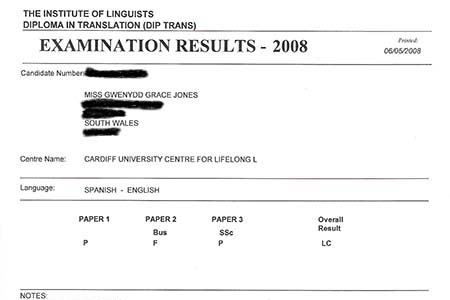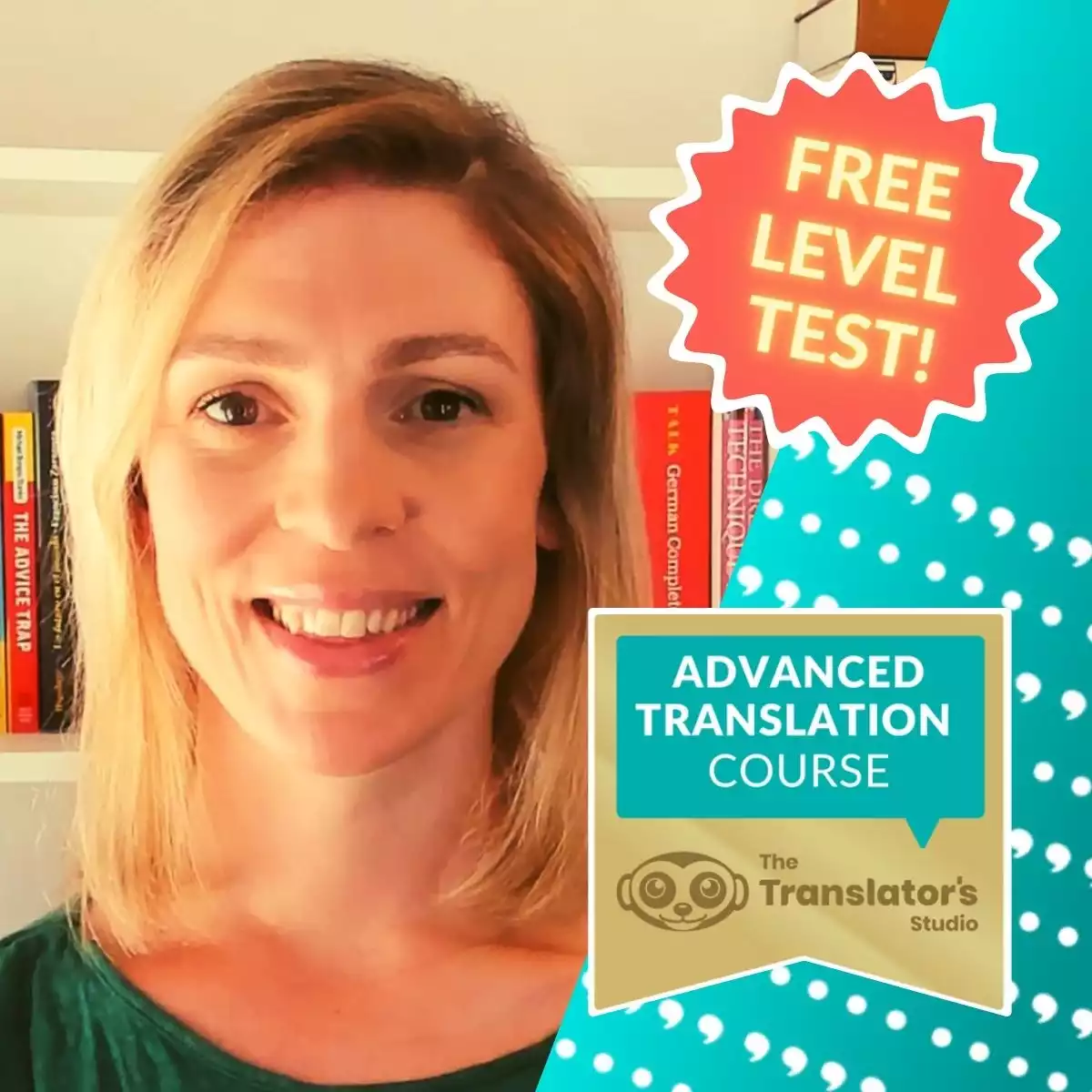Planning to sit the CIOL Diploma in Translation (DipTrans) offered by the Chartered Institute of Linguists? Judging by results from past years, about 25% of candidates will get a pass on at least one of the three papers. I first sat the Spanish-to-English DipTrans in 2008, and it was the first time in my life that I failed an exam.
While much has changed since 2008 and you can now sit the exam online (cue sigh of relief at not having to travel with a suitcase full of dictionaries), this article about what I did wrong can sill help you pass all three papers first time.
It was dark and rainy in Cardiff, where I sat the DipTrans exam. I remember getting stuck in rush hour traffic afterwards. Exhausted, I already knew I’d failed paper 2.

How did I know I’d failed the CIOL Diploma in Translation?
It was a business paper and, in reference to the staff of a company, I wrote personal instead of personnel, several times. I don’t know if that was the only mistake I made, but it was a bad one.
As soon as I walked out of the exam room, I realised I’d done it. I could actually visualise it. That means I’d observed it in the text, that somewhere in my subconscious I knew it was there. But it hadn’t made its way into the part of my brain that would jump on such an elementary mistake and correct it. HOW COULD I HAVE BEEN SO REMISS?
I had read over the text again and again, checking every word, or so I thought. I’m still kicking myself today.
So, why did I make a basic mistake in the exam?
Inexperience. I hadn’t done enough practice. Rookies make rookie errors and that was me in 2008. The CIOL Diploma in Translation exam is a test of practical skill. It isn’t like a typical exam where you answer a series of questions from memory. It tests your ability to produce professional work. It’s an exam that says: sit down and show me what you can do.
I hadn’t had the right guidance to help me identify the places I was most likely to make mistakes.
Here are five reasons why I couldn’t walk the walk that year in the CIOL DipTrans exam.
1. Inexperienced translators make elementary mistakes
Lots of people make the mistake of thinking that translation isn’t a learned skill. In fact, beyond being an extremely complex skill and one that you have to study if you want to master it, it takes years of experience to become an excellent translator. Inexperienced translators haven’t had time to make lots of mistakes and learn from them. I can assure you that I’ve never confused personal and personnel since that fateful day in 2008. The more opportunity you give yourself to make mistakes, the faster you’ll learn. That is, of course, as long as you get someone to help you identify them and show you how to improve.
See my article 9 Favourite Mistakes by Translators on our Translation Courses for some problem areas to look out for.
- Become a confident professional translator
- Learn fast with our extremely detailed feedback
- Prepare for the CertTrans exam
- Get your translation certificate
2. I couldn’t handle the time pressure in the DipTrans exam
Papers two and three of the CIOL Diploma in Translation exam give you two hours to translate 450 words. These days, an hour and a half to translate 450 words normally leaves time to spare. But in the early days, it was nail-bitingly tight. Pressure isn’t good for quality. The more translation practice you do, the faster you get. Practice makes perfect.
3. I was editing my translation when I should have been proofreading it
At that point in my development, I hadn’t learned how to see each word individually when proofreading. That is how I missed personal. I didn’t see it because I was focussing at sentence level and so it got camouflaged among all the other words. I forgot I had to actually see each individual word and letter.
Check out 10 Proofreading Mistakes by Trainees on our DipTrans Online Course for help with this.
4. I didn’t know the technique of doing different readings for specific aspects of the text
A translator has to make a large number of fast decisions one after another, which can be overwhelming. One way of getting around this is forcing your mind to focus on different aspects. So, when checking, you do one reading for grammar, one reading for terminology, one reading for style, one reading for spelling and so on, until time is up. The more experienced you get, the more you’re able to observe in a single reading. But, when you’re learning, breaking the text down and looking for specific problems can help.
It isn’t like a typical exam where you answer a series of questions from memory.
5. I didn’t know myself as a translator
I hadn’t had the right guidance to help me identify the places I was most likely to make mistakes. That means I didn’t know where I should be double checking myself. If you don’t know the errors you make, you have no chance of seeing them. If you don’t see them, you’ll never correct them. It all starts by admitting you have a problem with spelling personnel. Which, by the way, I don’t anymore.
Get more tips for success in the DipTrans.
Road to CIOL Diploma in Translation (DipTrans) success
I’ve spent many an hour chewing over that failed Paper 2. Anyone who’s ever failed the Diploma in Translation exam will know what I mean when I say I took it personnelly. (Sorry, I couldn’t resist.) My conclusion was that lack of guided practice and experience is one of the main reasons why translators fail the DipTrans.
If you want to do the CIOL Diploma in Translation, you need to practise and get experience before you attempt it. A high-quality DipTrans preparation course like ours is essential. A good tutor will help you identify your mistakes and learn how to correct them. It’s our mission to provide the most detailed feedback you’ll get anywhere, including on MA courses.
- Become a more successful translator
- Learn fast with extremely detailed feedback
- Prepare to pass the CIOL DipTrans exam
- Get your advanced translation certificate
If you want to get up to level to sit the DipTrans in the Spanish-to-English combination, look no further. Join us on our Professional Translation Conversion Course (Pre-DipTrans/CertTrans) or Advanced translation course (for experienced translators). Since that first exam, I’ve completed two translation MAs and the DipTrans. I’ve also translated millions of words of professional texts. Through the courses, you’ll get to know me personally and I’ll share everything I know with you.
I work closely with my course trainees to help them understand themselves as translators. Once you can do that, the DipTrans exam becomes easier to manage. But even if you make that serious mistake on the big day, you’ll still come away knowing how to produce a professional a translation.
Free level test
Not sure whether you have the level? Do your free test.
|
|
- Become a confident professional translator
- Learn fast with our extremely detailed feedback
- Prepare to pass the CertTrans exam
- Get your translation certificate
- Network in our private Facebook group
- Become a more successful translator
- Learn fast with our extremely detailed feedback
- Prepare to pass the CIOL DipTrans exam
- Get your advanced translation certificate
- Network in our private Facebook group







I agree with everything you said. The DipTrans is not easy-peasy even for experienced professionals as there is little time to ponder each and every word and the inability to perform online research forces you to work in an unusual context. During my sitting, I recognized many tricky words and expressions that had me puzzled in my early days as a translator. Using a course or preparing with a more experienced colleague is, in my opinion, essential. Translators are often lone wolves and having someone to check your performance is the best way to improve yourself (and not just in light of the DipTrans!).
Thank you very much for this comment. Yes, not being able to research online makes a tough exam even more challenging.